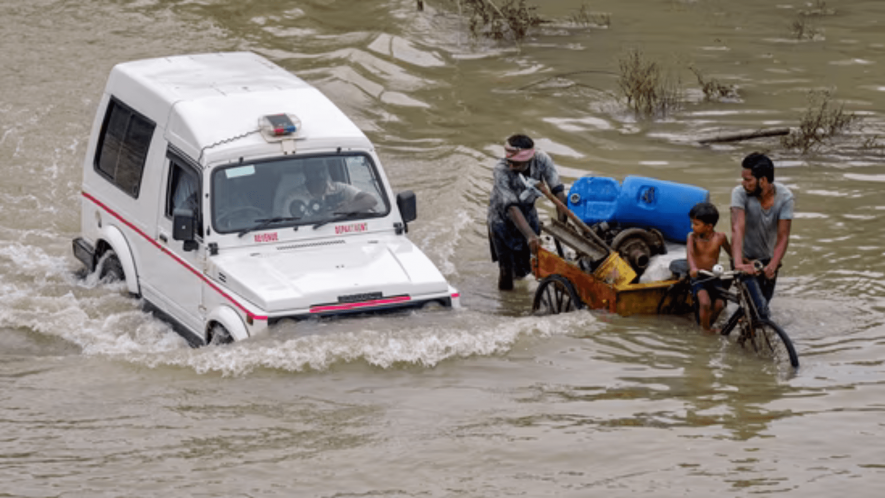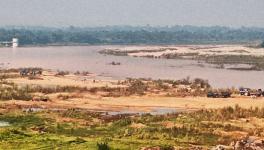Why Indian Cities Still Unprepared for Flooding

People from low-lying areas relocate to a safer place with their belongings after the Yamuna river inundated the nearby areas during monsoon season at Mayur Vihar in New Delhi. Image Courtesy: PTI
Urban flood disasters have incrementally increased over the past three decades. According to the National Disaster Management Authority, the most notable cities flooded in this period are Hyderabad in 2000, Ahmedabad in 2001, Delhi in 2002 and 2003, Chennai in 2004, Mumbai in 2005, Surat in 2006, Kolkata in 2007, Jamshedpur in 2008, Delhi in 2009, Guwahati and Delhi in 2010, and again in 2023, Srinagar in 2014, and Chennai in 2015. Even towns like Barmer, known as desert towns in the Thar desert, were not spared and have seen floods during this period.
Surprisingly, mountain towns, which hardly witnessed flooding as water washed down the slopes, have also witnessed some of the worst forms of flooding, triggering massive landslides. Examples include Dharamshala and Shimla.
According to a response in the Indian parliament, over 17,000 people died in floods and heavy rains between 2012 and 2021 in the country. Considering the latest report from the Intergovernmental Panel on Climate Change (IPCC), specifically Reports VI and the findings of Working Groups 1, 2, and 3, these disasters should not come as a surprise. The IPCC Report warns the Indian subcontinent of increased extreme climate events, particularly in two specific zones: coastal areas and the Himalayas. Anticipated trends include intensified rainfall occurring in shorter timeframes, meaning more rain in less time. Without climate-resilient urban infrastructure, flooding and landslides are imminent.
The National Disaster Management Authority (NDMA) states that the urban heat island effect has increased rainfall over urban areas due to global climate change, resulting in altered weather patterns and more high-intensity rainfall events in shorter periods. The threat of sea-level rise is also looming large, endangering coastal cities, riverside areas, dam upstreams/downstreams, inland cities, and hilly regions alike.
This phenomenon has been witnessed with increasing rapidity in recent decades. Urbanisation is transforming India's landscape at an unprecedented pace. Structural changes, brought about by liberalisation since the mid-90s, promoted cities as 'engines of growth' to attract investments. This led to reforms in land laws, making land readily available for real estate projects and fostering competition among cities. This trend was further reinforced by initiatives like the Jawaharlal Nehru Urban Renewal Mission (JNNURM) and the Smart City Mission (SCM), both emphasising project-oriented development of hard infrastructure.
However, this blind race resulted in the encroachment on urban commons, water bodies, disruption of water channels, alteration of water contours, and the conversion of open spaces into housing projects.
One consequence was the rapid expansion of cities. From 1991 to 2001, 221 towns and cities merged, compared to 100 in the preceding decade (1981-1991). The confluence of rapid development, poor planning, and climate change has led to recurrent urban flooding incidents, disrupting lives and causing economic losses.
Causes of Urban Flooding
Every city has its peculiarities and is adapted or un-adapted to flood risks in a manner of its historical evolution. However, some common areas need a universal approach for minimising the loss incurred by urban floods, eventually leading to disasters.
Drainage System:
One of the primary reasons for urban flooding in Indian cities is the inadequate drainage infrastructure. Many urban areas lack well-designed stormwater drainage systems capable of handling heavy rainfall. As cities expand without proper planning, impervious surfaces like roads and buildings prevent water from seeping into the ground, overwhelming the insufficient drainage systems. The design of the drains is also an important feature. Concretising the drains and not allowing the water to percolate in the ground further compounds the flooding problem.
Urbanisation:
Rapid urbanisation, both planned and unplanned, is also responsible for flooding. Take, for example, the construction of flyovers, widening of roads, and urban settlements - or what is called ‘grey’ infrastructure - in a planned manner, duly approved by the competent authorities, but in water-logged areas, all of them are responsible for urban flooding. Floods in Gurgaon and Bangalore are examples of such planning failures. Another failure is the construction of highways traversing water bodies that feed rivers and streams; such construction is also a major reason for urban flooding. For example, the ‘Kisan Path’ in Lucknow-circular Road circumferences the entire district. It has affected the Kukrail River in Lucknow and has blocked the drainage near the origin of the river.
Gurugram experiences floods during rains mainly because of severe disruption of the natural drainage system caused by the construction of roads and permanent concrete structures on wetlands.
Another major reason is improper waste disposal practices. Clogged drains and waterways filled with solid waste prevent water from flowing freely, exacerbating flood risks. The lack of proper waste management systems in many cities worsens this problem.
Loss of Urban Commons:
Many cities have witnessed encroachment and illegal construction on water bodies like lakes, ponds, and rivers, and in urban green patches or mini forests, often referred to as ‘blue infrastructure’. This results in reduced water storage capacity and disrupts the natural water flow, leading to increased flooding during heavy rains. Likewise, massive land use change from open spaces, parks, and playgrounds to more concrete surfaces in the form of built-in areas and real estate reduces the water percolating in the ground and instead triggers flooding.
To ensure that we make our cities resilient, liveable, and safer, we need a multifaceted approach for effective mitigation. This hinges on planning, which centrally includes ‘Cityzens’ and outlines short-term and medium-term collective action plans. From our experience of working with urban floods, the following are the fundamentals:
-
Creating Climate Atlas:
Before a development plan, every town and city must prepare its climate plan of action and, thus, a climate atlas. The climate atlas must be done with the active participation of the people. The vulnerable points must be identified, water contouring must be done, and a complete ‘no’ should be the reverberating voice for damaging the water bodies or channels. Likewise, capacity building of the people must be built to adapt to flooding and other climate disasters.
-
Sustainable Urban Planning:
Cities need to embrace sustainable urban planning practices that consider the natural topography and hydrology of the region. This includes preserving natural water bodies and floodplains, as well as integrating green spaces that can absorb excess water. Flood-resilient infrastructure must be built that includes minimal engagement with the water contours. Improved drainage systems can help in minimising and combating flooding in urban spaces. Improved water management methods by enhancing waste collection and segregation must be practised. A protocol for clearing the drains during the summer months must be followed. Simultaneously, green cover must be increased, and a massive drive for reforestation must be unleashed.
Early warning systems play an important role in minimising the loss to human lives. Timely alerts can help in responding swiftly and can save lives and assets. People must be at the centre of preparing disaster mitigation and adaptation strategies.
To minimise the loss from urban flooding, what is required is a multi-faceted approach for effective mitigation. Climate resilient strategies firmly rooted in a pro-people approach and a complete ‘no’ to occupying water bodies must be the priority to meet the challenges of urban flooding.
Sandeep Chachra is the executive director of Action Aid India.
Tikender Singh Panwar is the former directly elected Deputy Mayor of Shimla.
(Views expressed are personal)
Get the latest reports & analysis with people's perspective on Protests, movements & deep analytical videos, discussions of the current affairs in your Telegram app. Subscribe to NewsClick's Telegram channel & get Real-Time updates on stories, as they get published on our website.























